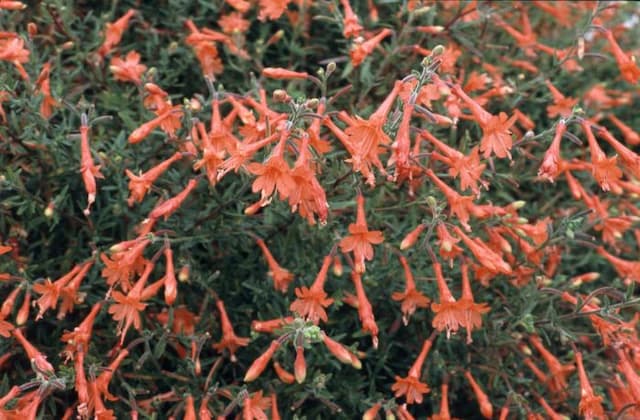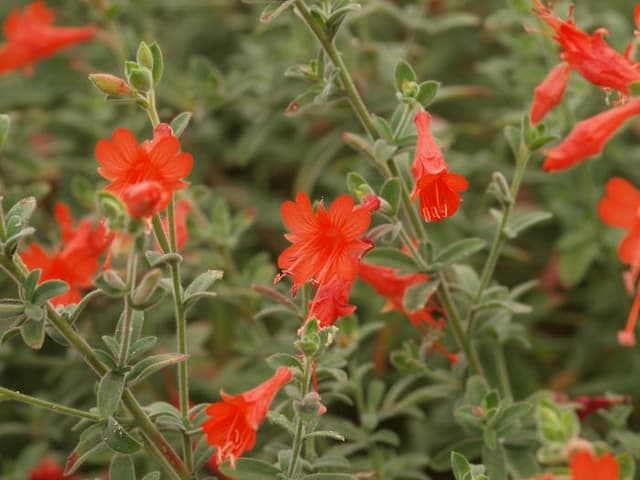Fuchsia Fuchsia 'Wapenveld's Bloei'

ABOUT
Fuchsia 'Wapenveld's Bloei', commonly known as fuchsia, boasts a stunning display of flowers with a distinctive appearance that makes them stand out in the garden. Each bloom is a masterful combination of two colors—a deep purple or pink outer layer that gracefully encases a softer, lavender or even white inner layer that seems to burst forth in a dramatic skirt-like fashion. Hanging like decorative ornaments, the flowers feature long, pendulous stamens that emerge from the center, adding to their exotic charm. The petals are tender and have a slightly tear-shaped form, creating a whimsical, lantern-like silhouette. Surrounding the enchanting flowers are vibrant green leaves, which have a slight sheen and create a luscious backdrop for the floral display. The leaves are elongated, with a soft ovate to elliptical shape, often showing subtle serration along the edges. Together, the vivid blooms and rich foliage give Fuchsia 'Wapenveld's Bloei' a lush and attractive appearance that is favored by gardeners looking to add a splash of color and elegance to their plant collections.
About this plant
 Names
NamesFamily
Onagraceae
Synonyms
Lady's Eardrops, Fairy Bells, Hummingbird Fuchsia
Common names
Fuchsia 'Wapenveld's Bloei'.
 Toxicity
ToxicityTo humans
Fuchsia plants, including the 'Wapenveld's Bloei' variety, are generally considered non-toxic to humans. Ingesting parts of fuchsia plants is not likely to cause poisoning or severe symptoms in humans. However, eating non-food plants can potentially cause mild digestive upset in some individuals, so it is not recommended to consume any part of fuchsia plants. Always exercise caution and keep plants out of reach of small children who might inadvertently consume plant parts.
To pets
Fuchsia plants are also considered non-toxic to pets. This includes the 'Wapenveld's Bloei' variety. While ingestion of fuchsia plants is not likely to lead to severe poisoning or long-lasting effects in pets, consumption of plant material can sometimes result in mild gastrointestinal upset, such as vomiting or diarrhea, especially if consumed in large amounts. It is always prudent to prevent pets from ingesting plants to avoid any potential discomfort.
 Characteristics
CharacteristicsLife cycle
Perennials
Foliage type
Deciduous
Color of leaves
Green
Flower color
Mixed
Height
1-2 feet (30-60 cm)
Spread
1-2 feet (30-60 cm)
Plant type
Shrub
Hardiness zones
9
Native area
Central and South America
Benefits
 General Benefits
General Benefits- Aesthetic Appeal: Adds visual interest to gardens with its unique and colorful hanging flowers.
- Attracts Wildlife: Draws hummingbirds and butterflies, providing natural pollination.
- Versatility in Gardening: Suitable for planting in hanging baskets, containers, and borders.
- Shade Tolerance: Thrives in partly shaded conditions where other sun-loving plants may not.
- Easy Propagation: Can be easily propagated from cuttings, allowing gardeners to expand their collection.
- Long Blooming: Offers a lengthy blooming period from late spring to fall, enhancing garden color for an extended time.
- Low Maintenance: Requires minimal care once established, making it ideal for busy gardeners.
 Medical Properties
Medical PropertiesThis plant is not used for medical purposes.
 Air-purifying Qualities
Air-purifying QualitiesThis plant is not specifically known for air purifying qualities.
 Other Uses
Other Uses- Fuchsia 'Wapenveld's Bloei' can be used as a source of nectar for hummingbirds; gardeners sometimes plant them specifically to attract these birds.
- The vibrant flowers can be used in making natural dyes for textiles, offering a range of pink and purple hues depending on the mordant used.
- The plant can be trained to grow as a bonsai, making it an artistic addition to indoor plant collections.
- Its flowers can be used in garnishing dishes and salads, provided they have been grown without harmful pesticides.
- Fuchsia can be used as a living mulch in larger garden beds, where their dense foliage can help suppress weeds and retain soil moisture.
- These plants can be part of a sensory garden due to their textured leaves and visually striking flowers, which are appealing to touch and sight.
- Some crafters use the dried flowers in potpourri mixes, adding color and a soft, subtle fragrance to the blend.
- Fuchsia flowers can be used in the preparation of syrups and jams, although they are not commonly used for this purpose.
- In photography and painting, the plant provides a rich subject because of its drooping flowers and contrasting colors, allowing for artistic depiction.
- Fuchsia 'Wapenveld's Bloei' can be used to create living fences or privacy screens in gardens when planted in a row.
Interesting Facts
 Feng Shui
Feng ShuiFuchsia is not used in Feng Shui practice.
 Zodiac Sign Compitability
Zodiac Sign CompitabilityFuchsia is not used in astrology practice.
 Plant Symbolism
Plant Symbolism- Confiding Love: The Fuchsia plant is often associated with confiding love. The unique hanging blooms resemble delicate lanterns, potentially signifying a safe space to share one’s deepest feelings.
- Elegance and Good Taste: The graceful appearance of Fuchsia flowers, with their exquisite shape and vibrant colors, represents elegance and refinement, often attributed to individuals with discerning tastes.
- Astuteness: Fuchsias can symbolize astuteness or cleverness. This might be due to the plant's ability to thrive in various growing conditions, reflecting adaptability and intelligence.
- Overflowing Abundance: A mature Fuchsia plant, laden with many blossoms, can represent abundance and plenitude, possibly reflecting a generous or bountiful personality or situation.
- Amiability: The charming and friendly look of the Fuchsia bloom could be seen to represent amiability, suggesting a friendly, approachable person or environment.
 Water
WaterThe Fuchsia 'Wapenveld's Bloei', commonly known as Hardy Fuchsia, requires consistent moisture and should be watered when the top inch of soil feels dry to the touch. To ensure proper hydration, water the plant thoroughly, allowing the water to seep deeply into the soil, which might mean providing about half a gallon for a medium-sized pot every few days during the active growing season. During cooler months, reduce watering frequency as the plant's growth slows down, but do not let the soil completely dry out. Over-watering can lead to issues such as root rot, so ensure that the pot has good drainage. Be attentive to your plant's needs; during hot weather or windy conditions, it may require more frequent watering.
 Light
LightHardy Fuchsia thrives in a location where it receives morning sunlight and afternoon shade, as intense afternoon sun can damage the leaves and flowers. The ideal lighting condition is bright but indirect light. A spot that is shielded from the harshest rays of the day, such as an eastern-facing spot or under a canopy of light tree foliage, is perfect for these plants.
 Temperature
TemperatureHardy Fuchsia prefers a temperate climate and does well in temperatures ranging from about 60 to 75 degrees Fahrenheit for optimal growth. It can survive in temperatures as low as 40 degrees Fahrenheit, but it is important to protect it from frost. In areas with hot summers, positioning the plant in a spot where it can stay cool during peak heat is beneficial.
 Pruning
PruningPruning is essential for maintaining a robust and well-shaped Hardy Fuchsia plant; it promotes healthy growth and abundant flowering. Prune in late winter or early spring, trimming away any dead or weak stems to encourage new growth. Additionally, after the Fuchsia has finished flowering, trim off spent flowers to keep the plant tidy and encourage further blooming. The best time for a major prune is when the plant is dormant, before new growth begins.
 Cleaning
CleaningAs needed
 Soil
SoilFuchsias, including 'Wapenveld's Bloei', prefer a well-draining soil mix composed of loam, peat moss, and perlite or sand to aid drainage. The ideal soil pH for fuchsias should be slightly acidic to neutral, ranging from 6.0 to 7.0.
 Repotting
RepottingFuchsias should be repotted annually, ideally in the spring, as they prefer to be in fresh soil and can become root-bound if left too long in the same pot.
 Humidity & Misting
Humidity & MistingFuchsias thrive in moderate to high humidity levels, around 60% to 70%. They require a moist environment but should not be subjected to wet or waterlogged conditions.
 Suitable locations
Suitable locationsIndoor
Place in bright, indirect light and ensure high humidity.
Outdoor
Protect from hot sun; plant in shade or semi-shade.
Hardiness zone
10-11 USDA
 Life cycle
Life cycleFuchsia 'Wapenveld's Bloei' begins with seed germination, where environmental conditions such as warmth and moisture trigger the sprouting of the seed. The seedling phase follows, characterized by the emergence of the first leaves and development of the root system. As the fuchsia enters the vegetative stage, the plant exhibits growth of stems and foliage, preparing for the flowering phase. During the flowering phase, Fuchsia 'Wapenveld's Bloei' produces distinctive, vibrant blooms for which it is renowned. After pollination, the plant may produce berries containing seeds, leading to the reproductive phase where these seeds can be dispersed to start new plants. Eventually, the plant enters senescence and dies back, especially in regions with colder climates, though it may regrow from the base in the next growing season if conditions are favorable.
 Propogation
PropogationPropogation time
Spring-Summer
Fuchsia 'Wapenveld's Bloei', commonly known as Hardy Fuchsia, is typically propagated by softwood cuttings. The most favorable time to begin this process is in the late spring or early summer when the plant's growth is active and the stems are green and flexible. To propagate, a 4 to 6-inch cutting (which is about 10 to 15 centimeters) is taken just above a leaf node using a sharp, clean pair of pruners. Strip the bottom half of the cutting of any leaves and dip the cut end in a rooting hormone. The cutting is then placed in a well-draining, moist potting mix and covered with a plastic bag or placed in a propagator to maintain high humidity. Roots typically develop within a few weeks, after which the cutting can be transplanted to a larger pot or directly into the garden.









